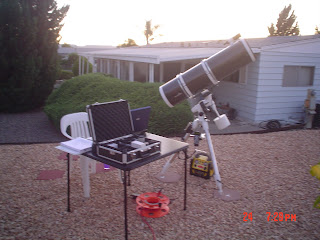
Here's my 1st attempt at M8. I found I'm just a wee bit out of focus so will try harder next time (need to make a "Hartmann Mask" for the new scope).
Sky-Watcher SW254N with EQ5 pro mount, Meade DSI IIc camera 20 images @ 15 sec each.
The Lagoon Nebula (catalogued as Messier 8 or M8, and as NGC 6523) is a giant interstellar cloud in the constellation Sagittarius. It is classified as an emission nebula and as an H II region.
The Lagoon Nebula was discovered by Guillaume Le Gentil in 1747 and is one of only two star-forming nebulae faintly visible to the naked eye from mid-northern latitudes. Seen with binoculars, it appears as a distinct oval cloudlike patch with a definite core. A fragile star cluster appears superimposed on it.






